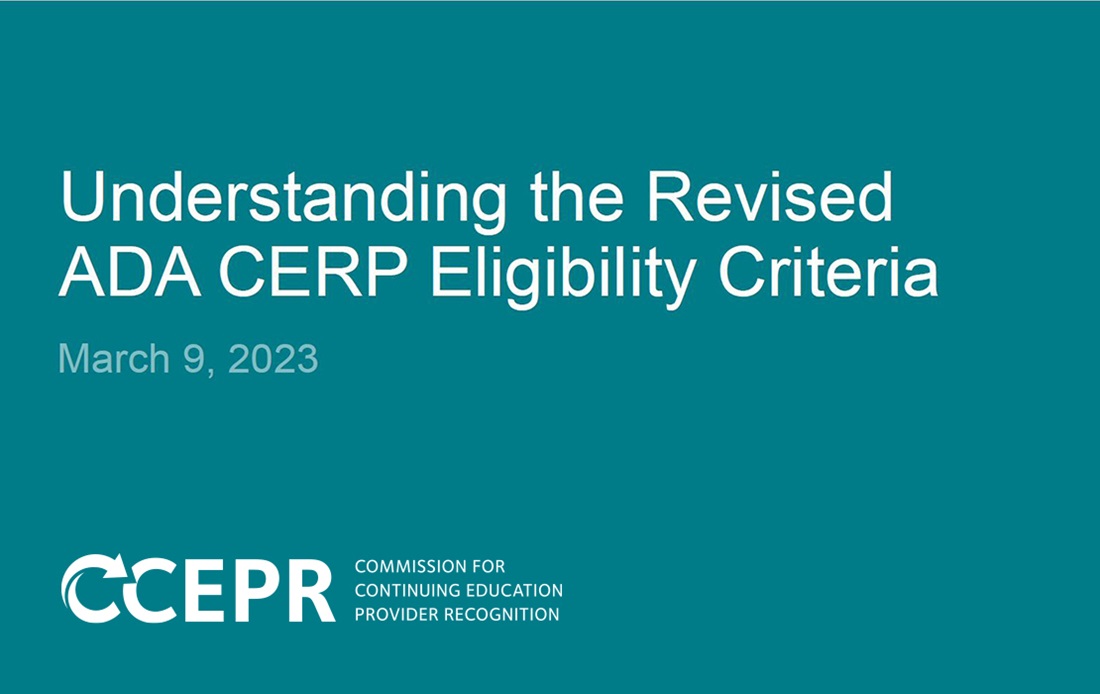ADA CERP recognized providers are required to indicate their recognition status in publicity materials, course materials and in verification of participation documents. Provisions for referencing ADA CERP recognition are contained in the ADA CERP Recognition Standards and Procedures, available at ADA.org/CERP, and in the ADA CERP License Agreement, which recognized providers are required to sign. These provisions are summarized below to assist your organization in complying with the terms and conditions.
Recognized providers must use the following statements regarding recognition status, credit designation and notice of opportunity to file complaints on materials related to their continuing education activities.
Publicity materials
The following authorized recognition and credit designation statements must be used on publicity materials related to the provider’s continuing education courses:
<> is an ADA CERP Recognized Provider.
ADA CERP is a service of the American Dental Association to assist dental professionals in identifying quality providers of continuing dental education. ADA CERP does not approve or endorse individual courses or instructors, nor does it imply acceptance of credit hours by boards of dentistry.
<<Name of provider>> designates this activity for <<Name of provider>> continuing education credits.
Course materials and verification of participation forms
The following authorized recognition statement and notice of opportunity to file complaints must be published by recognized providers in course materials available to participants during the activity, such as program guides, evaluation forms, instructions for self-study activities, etc., and on all verification of participation documents issued by the provider for continuing dental education activities:
<<name of provider>> is an ADA CERP Recognized Provider.
ADA CERP is a service of the American Dental Association to assist dental professionals in identifying quality providers of continuing dental education. ADA CERP does not approve or endorse individual courses or instructors, nor does it imply acceptance of credit hours by boards of dentistry.
Concerns or complaints about a CE provider may be directed to the provider or to the Commission for Continuing Education Provider Recognition at CCEPR.ada.org.
Joint Providership
When an ADA CERP recognized provider jointly provides a CDE activity with one or more other CE providers, the CERP recognized provider must inform participants of the joint providership arrangement using the following statement:
This continuing education activity has been planned and implemented in accordance with the standards of the ADA Continuing Education Recognition Program (ADA CERP) through joint efforts between <> and <>.
This statement must be used in addition to the authorized recognition statements described above. (See also ADA CERP Joint Providership Policy and the ADA CERP Glossary.)
Use of the ADA CERP logo
The ADA CERP logo may not be used without the authorized recognition statements above. (However, the recognition statements may be used alone.)
The logo may not be given greater prominence than the name of the CE provider or the provider’s logo. Policies governing the use of the ADA CERP logo are listed below:
It shall not be used to imply that any CE activities or CE credit hours have been approved or endorsed by ADA CERP or the ADA
It shall not be used on letterheads or in any fashion that would imply that the organization is affiliated with ADA CERP or the ADA, other than as a recognized provider
It may not be displayed in a type size larger than the provider organization’s name, or given greater prominence than the provider organization’s name
It shall not be published in conjunction with any statement or material that, in the ADA’s judgment, may be harmful to the ADA’s goodwill or may tend to undermine the ADA’s credibility
It shall only be used in conjunction with the authorized statement that the organization is a recognized provider
